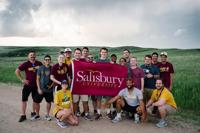By Sean Foy
SALISBURY, Md.- When you see a storm approaching in the distance, you usually seek shelter or drive in the opposite direction. But earlier this month, 14 Salisbury University students did the exact opposite and they received school credit for it.
The group, which was mostly composed of geography majors and minors, took 10 days at the beginning of June to go storm chasing. Storm chasing is the act of predicting and following severe weather in order to gather data on storms, take pictures, or simply to experience the thrill of watching a tornado make its first contact with the ground. For these students, it was all of the above.
This was part of a new course offered by Salisbury University, where students travel out to the landlocked states of America's tornado alley to experience in person the weather phenomena that they learned about in their meteorology and atmospheric science classes.
The course is the first of its kind for the school and was taught by Dr. Darren Parnell and Dr. Craig Ramseyer, who teach meteorology and climatology at SU's Department of Geography and Geosciences.
Parnell says the course is important for SU students "because they will get experience in 'nowcasting,' which is the forecasting of the atmosphere in real-time." In addition to these practical applications, Ramseyer wanted the students to walk away from the course with experiences in parts of the country they would not otherwise have.
"The Great Plains are normally thought of as this homogeneous landscape with little to offer in the way of scenery and activities," he said. But Ramseyer thinks now that the students have been out there, they would say otherwise.
Rising senior Roger Riggin agreed with Ramseyer.
"In 9 days we got to see more of the continental US then most people do in their lifetime. The west is absolutely beautiful," he said.
The group flew into Denver International Airport in Colorado on Thursday, May 31. They then proceeded to traveled through Nebraska, Wyoming, New Mexico, Texas and a stop at the Oklahoma border to track down supercell storms and hopefully spot a tornado.
During their trip they traveled nearly 3,400 miles in their rental vans. That is more mileage then you would gain driving from New York City to San Francisco.
This is what a typical day on their trip looked like:
A Typical Chase Day
- 7 a.m. – Meet in common area at hotel and start forecasting during breakfast.
- 8 a.m. – Finish breakfast and come up with target location.
- 8:30 a.m. – Everyone in the van ready to leave.
- 8:30 a.m. – 12:30 PM – Driving.
- 12:30 – 12:50 p.m. – A very quick lunch of fast food. This may even consist of eating the lunch in the van.
- 2:30 p.m. – Arrive at target location and setup at park to wait for storm to start.
- 4 p.m. – Chase a supercell storm until it dissipates or a better storm is found.
- 9:45 p.m. – Head to dinner close to the next hotel.
- 11:30 p.m. – Light’s out.

Students use weather forecasting systems to predict the location of severe weather. (Photo: Craig Ramseyer)Craig Ramseyer
While inspecting maps and radars they raced across states to find an optimal and safe spot to watch a storm. Sometimes they had to move locations with minutes to spare before the storms initiated. They saw large hail falling from the sky and experienced the heavy winds that fuel a storm as a funnel cloud of a tornado formed in the sky.
The trip offered the students the opportunity to experience the type of weather they likely had only read about in their textbooks and watched online. Rising junior Avery Strayer highlights the "multiple lightning shows" they witnessed as one of his favorite sights.
"The Salisbury storm chasing course is something I will remember for the rest of my life," he said.
Beautiful days with blue skies and no clouds in sight would be considered poor weather days in the storm chaser community. With a calm, stable atmosphere there are no chances of severe whether to observe. On those days the class was able to relax and visit some of the many national parks the U.S. has to offer. Rising senior Max Magness enjoyed these off days.
"By far the best trip I've ever been. Not just because we chased storms, but because we visited many other attractions," he said.

The SU storm chasing class visited the Great Sand Dunes in Colorado on one of their days off. (Photo: Craig Ramseyer)Craig Ramseyer
Ramseyer says his favorite part of the trip was "seeing the students' reactions to all they were experiencing. Seeing the looks of awe and wonderment on the students’ faces while we were watching a supercell thunderstorm was a very gratifying experience. I would say it was the most gratifying experience in my time as a professor at SU."
Parnell had his best experience at the tail end of the trip on Thursday, June 7. It was day eight of the course and they were driving toward Lusk, Wyoming.
"We waited patiently for the supercell thunderstorms to form at a local park and then correctly drove to an ideal location to observe a developing supercell," Parnell said. "This was a great last chase day for us and about as classic of a rotating wall cloud as you will see. The drive to Cheyenne that evening and then celebrating the Capitals winning the Stanley Cup was a great way to end the day."

The SU storm chasing class spotted this rotating supercell in Wyoming. (Photo: Craig Ramseyer)Craig Ramseyer
Both professors considered the course to be very successful and plan to offer this course every other year, but are willing to provide it every year if the demand of the class is high enough.
The next time this course will be offered again will be in the Salisbury University summer semester of 2020.









